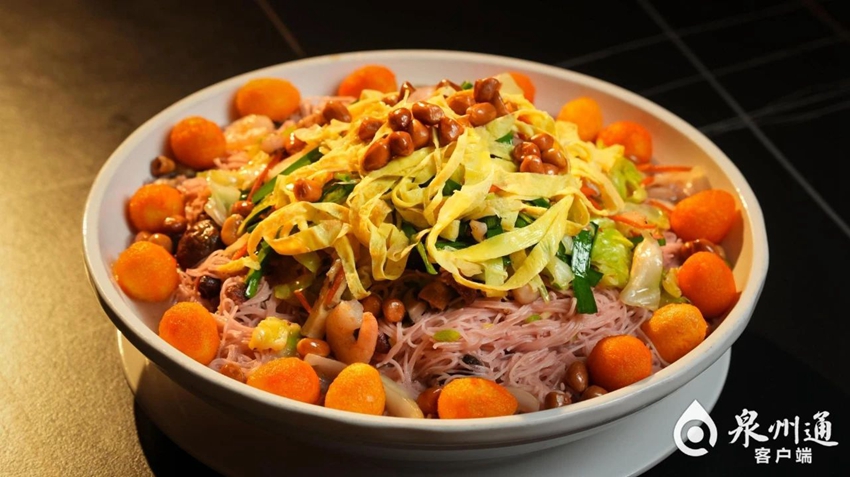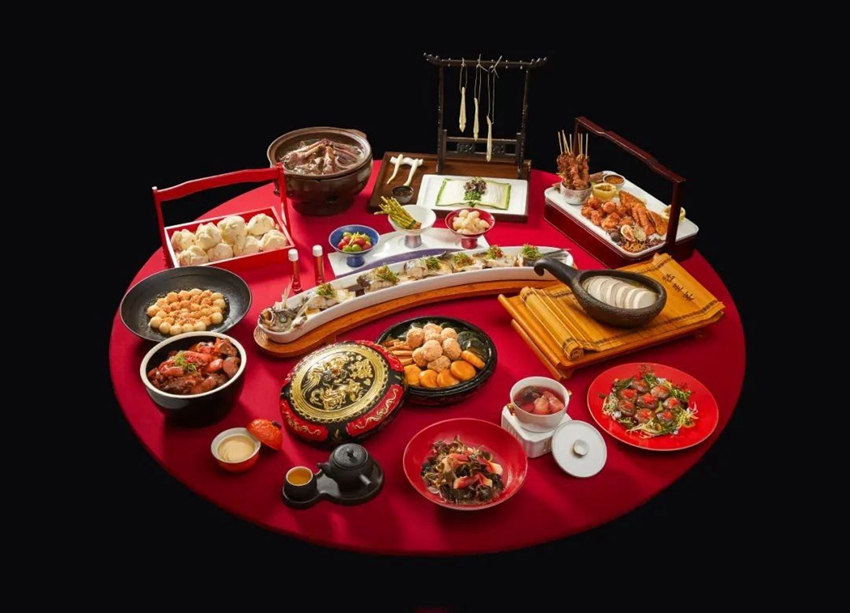- Guide
- Flavors
Flavors That Define a City
Food is more than sustenance—it is the soul of a city, a flavorful signature that carries its history, identity, and traditions. This Lunar New Year, as the Year of the Snake unfolds, Quanzhou unveils its"One County, One Table"initiative, spotlighting regional delicacies that encapsulate the city's rich culinary heritage. As families gather over dishes steeped in history, the warmth of homecoming is served with every bite.

Red Mushroom Longevity Noodles
A Culinary Homecoming: Nostalgia on a Plate
For those who have spent years away, nothing stirs the heart quite like the flavors of home. On the 27th day of the lunar calendar, Guo Meilin, a businessman with the Quangang Chamber of Commerce in Guangzhou, embarked on an 11-hour journey back to Quanzhou for the New Year. His fatigue melted away the moment he tasted his aunt's braised noodles (lu mian)—a dish redolent of childhood memories.
In Quangang, staples like braised noodles, longevity noodles with red mushrooms, and oyster and seaweed stew are part of everyday life yet remain elusive outside the region. While Minnan cuisine is available in Guangdong, Guo insists that no version quite captures the authenticity of home. Recognizing this deep-rooted connection between food and identity, the Quangang Business Bureau and other local organizations hosted a "Quangang Fortune Banquet"in Guangzhou, allowing overseas Quanzhou natives to reconnect with their culinary heritage.
This year, Guo's return felt even more special. With hotels and restaurants across Quanzhou offering curated "One County, One Table"menus, he looked forward to introducing his visiting friends to the city's storied Minnan flavors and rich food culture.

Kui Xing Banquet
Cultural Feasts: A Scholar's Perspective
For young scholars returning home, food serves as a bridge between past and future. On the 27th day of the lunar month, students from Tsinghua and Peking University convened in Yongchun to discuss their hometown's development—over a feast. The"Kui Xing Banquet"is no ordinary meal;it is a 12-course culinary narrative, weaving together local ingredients, history, and intangible cultural heritage.
Liu Qiwei, a PhD student in mechanical engineering at Tsinghua University, described the banquet as"a cultural bridge."Standout dishes included the"Taoyuan Four Delights"served in traditional lacquerware, aged vinegar pork knuckles, and kumquat steamed buns—each symbolizing academic success.Inspired by the depth of tradition, Liu hoped to share this"cultural table"with his professors and peers back in Beijing.

19 Signature Dishes of the "Zan Hua Banquet"
A Heritage-Infused New Year: Culinary Tourism in Quanzhou
A festive feast in Quanzhou extends beyond the dining table—it is an experience, a story told through flavors and rituals. The"Zan Hua Banquet"(Floral Hairpin Banquet)has become a social media sensation, prompting both locals and tourists to seek out its storied dishes.
Chen, a visitor from Ningbo, reserved a spot at the banquet the moment she checked into her hotel, drawn by online buzz. The menu, featuring"Auspicious Three Treasures,""Bountiful Seafood,"and"Oysters Rising to Success,"reflects both culinary artistry and symbolic well-wishing for the new year.
But Quanzhou's Lunar New Year is more than just a feast—it is a multisensory celebration of heritage. Visitors can immerse themselves in traditional puppet shows, flower-pinning rituals, handcrafted lantern workshops, and live Nanyin music performances.For those seeking a moment of quiet beauty, a dedicated photography session captures the first sunrise of the new year over the East China Sea.
From homecoming feasts to cultural banquets and immersive heritage experiences, Quanzhou's Lunar New Year offers a journey where tradition and modernity harmoniously converge—one meal at a time.
